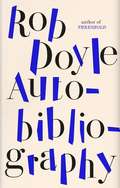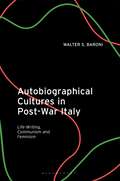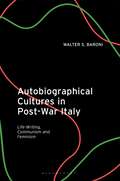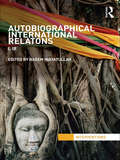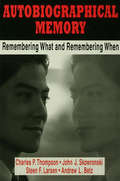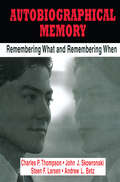- Table View
- List View
Autoantibodies: Methods and Protocols (Methods in Molecular Biology #1901)
by Gunnar HouenThis volume covers methods for determination of autoantibodies in rheumatic connective tissue diseases and organ-specific diseases. Written in the highly successful Methods in Molecular Biology series format, chapters include introductions to their respective topics, lists of the necessary materials and reagents, step-by-step, readily reproducible laboratory protocols, and tips on troubleshooting and avoiding known pitfalls. Authoritative and cutting-edge, Autoantibodies: Methods and Protocols aims to be helpful for all persons working with research and development of autoimmune laboratory diagnostics and for clinicians using autoantibody tests in daily work with patients.
Autoantibodies and Autoimmunity: Molecular Mechanisms in Health and Disease
by Kenneth Michael PollardThis is the first book to address all aspects of the biology of autoantibodies in a single volume, including a discussion of immunology, experimental models, clinical aspects, and the use of autoantibodies as probes in molecular and cellular biology. The editor, currently professor at the W.M. Keck Autoimmune Disease Center of The Scripps Research Institute, has assembled an all-star team of authors to report on the latest research, technologies, and applications. Following an introductory chapter, the book goes on to cover such topics as cellular mechanisms of autoantibody production, clinical and diagnostic usefulness in human disease, and animal models used to study the elicitation of autoantibodies. The whole is rounded off with a look at future perspectives. With its comprehensive coverage, this volume will appeal not only to immunologists and clinicians but also to cell and molecular biologists.
AutoBATS and 3D MUSIC: New Approaches to Imaging Earthquake Rupture Behaviors (Springer Theses)
by Pei-Ru JianThis book presents the kinematic earthquake rupture studies from moment tenor to spatial-temporal rupture imaging. For real-time seismic hazard monitoring, the new stable automatic moment tensor (AutoBATS) algorithm is developed and implemented for the real-time MT reports by the Taiwan Earthquake Science Information System (TESIS). In order to understand the rupture behavior of the 2013 Mw 8.3 Okhotsk deep earthquake sequence, the 3D MUltiple SIgnal Classification Back Projection (MUSIC BP) with P and pP phases is applied. The combined P- and pP-wave BP imaging of the mainshock shows two stages of anti-parallel ruptures along two depths separating for about 10~15 km. Unusual super-shear ruptures are observed through the 3D BP images of two Mw 6.7 aftershocks. In last two chapters, the 3D BP imaging reveals similar rupture properties of two shallow catastrophic earthquakes (Mw=6.4) in southwestern Taiwan. Both the 2010 Jiashian and 2016 Meinong earthquakes ruptured westward with similar velocity of ~2.5 km/s along a NE-ward shallow dipping blind fault. The rupture similarities of the doublet suggest two parallel elongate asperities along the causative fault. After several decades of seismic quiescence, the 2010 Jiashian event initiated the rupture at the deeper asperity and triggered the shallower asperity which caused catastrophes six years later.
Autobibliography
by Rob DoyleIn my case, reading has always served a dual purpose. In a positive sense, it offers sustenance, enlightenment, the bliss of fascination. In a negative sense, it is a means of withdrawal, of inhabiting a reality quarantined from one that often comes across as painful, alarming or downright distasteful. In the former sense, reading is like food; in the latter, it is like drugs or alcohol. In Autobibliography, Rob Doyle recounts a year spent rereading fifty-two books – from the Dhammapada and Marcus Aurelius, via The Tibetan Book of the Dead and La Rochefoucauld, to Robert Bolaño and Svetlana Alexievich – as well as the memories they trigger and the reverberations they create. It is a record of a year in reading, and of a lifetime of books. Provocative, intelligent and funny, it is a brilliant introduction to a personal canon by one of the most original and exciting writers around. It is a book about books, a book about reading, and a book about a writer. It is an autobibliography.
An Autobibliography by John Caius (Routledge Early Modern Translations)
by Vivian NuttonJohn Caius (1510–1573), second founder of Gonville and Caius College, Cambridge, was an English scholar with an international reputation in his lifetime as a naturalist, historian and medical writer. His Autobibliography is a major contribution to the history of English culture in the middle years of the sixteenth century and has been translated into English for the first time in this book. Beginning with an in-depth introduction to John Caius’ life and works, An Autobibliography by John Caius provides a wealth of information to support and accompany the translation of this significant text. In his Autobibliography, Caius lists the books that he wrote but also details the circumstances of their writing. He describes his travels in Italy in search of manuscripts of the ancient Greek doctor Galen of Pergamum as well as giving an insight into his personal life, including his vigorously conservative views, whether on medicine, spelling and pronunciation, or on Cambridge University. His religious views, which led to the ransacking of his rooms by a Cambridge mob, are explored in detail in Appendix II of this book. In Appendix I, recent discoveries of books owned and annotated by Caius are used to supplement what he says about his activities, as well as to trace at least one of his lost works in Italy and Denmark. The resulting picture throws light on European medicine in the sixteenth century, as well as on the humanistic culture that linked learned men and women across Renaissance Europe.
An Autobibliography by John Caius (Routledge Early Modern Translations)
by Vivian NuttonJohn Caius (1510–1573), second founder of Gonville and Caius College, Cambridge, was an English scholar with an international reputation in his lifetime as a naturalist, historian and medical writer. His Autobibliography is a major contribution to the history of English culture in the middle years of the sixteenth century and has been translated into English for the first time in this book. Beginning with an in-depth introduction to John Caius’ life and works, An Autobibliography by John Caius provides a wealth of information to support and accompany the translation of this significant text. In his Autobibliography, Caius lists the books that he wrote but also details the circumstances of their writing. He describes his travels in Italy in search of manuscripts of the ancient Greek doctor Galen of Pergamum as well as giving an insight into his personal life, including his vigorously conservative views, whether on medicine, spelling and pronunciation, or on Cambridge University. His religious views, which led to the ransacking of his rooms by a Cambridge mob, are explored in detail in Appendix II of this book. In Appendix I, recent discoveries of books owned and annotated by Caius are used to supplement what he says about his activities, as well as to trace at least one of his lost works in Italy and Denmark. The resulting picture throws light on European medicine in the sixteenth century, as well as on the humanistic culture that linked learned men and women across Renaissance Europe.
Autobiografische Updates: Jahresbriefe zur Bewältigung biografischer Unsicherheit
by Helga Pelizäus-HoffmeisterAutobiographical Comics (Bloomsbury Comics Studies)
by Andrew J. KunkaA complete guide to the history, form and contexts of the genre, Autobiographical Comics helps readers explore the increasingly popular genre of graphic life writing. In an accessible and easy-to-navigate format, the book covers such topics as: · The history and rise of autobiographical comics · Cultural contexts · Key texts – including Maus, Robert Crumb, Persepolis, Fun Home, and American Splendor · Important theoretical and critical approaches to autobiographical comics Autobiographical Comics includes a glossary of crucial critical terms, annotated guides to further reading and online resources and discussion questions to help students and readers develop their understanding of the genre and pursue independent study.
Autobiographical Comics (Bloomsbury Comics Studies)
by Andrew J. KunkaA complete guide to the history, form and contexts of the genre, Autobiographical Comics helps readers explore the increasingly popular genre of graphic life writing. In an accessible and easy-to-navigate format, the book covers such topics as: · The history and rise of autobiographical comics · Cultural contexts · Key texts – including Maus, Robert Crumb, Persepolis, Fun Home, and American Splendor · Important theoretical and critical approaches to autobiographical comics Autobiographical Comics includes a glossary of crucial critical terms, annotated guides to further reading and online resources and discussion questions to help students and readers develop their understanding of the genre and pursue independent study.
Autobiographical Cultures in Post-War Italy: Life-Writing, Communism and Feminism
by Walter S. BaroniAfter the Second World War, two contrasting political movements became increasingly active in Italy - the communist and feminist movements. In this book, Walter Baroni uses autobiographical life-writing from both movements key protagonists to shed new light on the history of these movements and more broadly the similarities and differences between political activists in post-war Italy.
Autobiographical Cultures in Post-War Italy: Life-Writing, Communism and Feminism
by Walter S. BaroniAfter the Second World War, two contrasting political movements became increasingly active in Italy - the communist and feminist movements. In this book, Walter Baroni uses autobiographical life-writing from both movements key protagonists to shed new light on the history of these movements and more broadly the similarities and differences between political activists in post-war Italy.
Autobiographical International Relations: I, IR (Interventions)
by Naeem InayatullahThis volume provides a novel approach to international relations. In the course of fifteen essays, scholars write about how life events brought them to their subject matter. They place their narratives in the larger context of world politics, culture, and history. Autobiographical International Relations believes that the fictive distancing associated with academic prose creates disaffection in both readers and writers. In contrast, these essays demonstrate how to reengage the "I" while simultaneously sustaining theoretical precision and historical awareness. Authors highlight their motives, their desires, and their wounds. By connecting their theoretical and practical engagements with their needs and wounds, and by working within the overlap between theory, history, and autobiography, these essays aim to increase the clarity, urgency, and meaningfulness of academic work. These essays are autobiographical, but focused on the academic aspect of authors’ lives. Specifically, they are set within the domain of international relations/global politics. They are theoretical, but geared to demonstrate that theoretical decisions emerge from theorists’ needs and wounds. Theoretical precision, rather than being explicitly deduced, is instead immanent to the autobiographical and the historical/cultural narrative each author portrays. And, these essays are framed in historical/cultural terms, but seek to bind together theory, history, culture, and the personal into a differentiated and vibrant whole. This book moves the field of International Relations towards greater candidness about how personal narrative influences theoretical articulations. No such volume currently exists in the field of international relations.
Autobiographical International Relations: I, IR (Interventions)
by Naeem InayatullahThis volume provides a novel approach to international relations. In the course of fifteen essays, scholars write about how life events brought them to their subject matter. They place their narratives in the larger context of world politics, culture, and history. Autobiographical International Relations believes that the fictive distancing associated with academic prose creates disaffection in both readers and writers. In contrast, these essays demonstrate how to reengage the "I" while simultaneously sustaining theoretical precision and historical awareness. Authors highlight their motives, their desires, and their wounds. By connecting their theoretical and practical engagements with their needs and wounds, and by working within the overlap between theory, history, and autobiography, these essays aim to increase the clarity, urgency, and meaningfulness of academic work. These essays are autobiographical, but focused on the academic aspect of authors’ lives. Specifically, they are set within the domain of international relations/global politics. They are theoretical, but geared to demonstrate that theoretical decisions emerge from theorists’ needs and wounds. Theoretical precision, rather than being explicitly deduced, is instead immanent to the autobiographical and the historical/cultural narrative each author portrays. And, these essays are framed in historical/cultural terms, but seek to bind together theory, history, culture, and the personal into a differentiated and vibrant whole. This book moves the field of International Relations towards greater candidness about how personal narrative influences theoretical articulations. No such volume currently exists in the field of international relations.
Autobiographical Lectures of Leaders in Art Education, 2001–2021: A Selection of Self-Reflections and Living Histories
by Stephanie Autumn Baer Katherine Coy Smith Stephanie Harvey DankerThis scholarly collection is a continuation of a lecture series highlighting the essential nature of biography in the history of art education. The editors feature 16 prominent art educators, organized into one of three chronological sections spanning the past two decades. The contributing art educators explore influences that shaped their beliefs about art education and the arts, describe their career paths, explain their philosophy of art education and its development, and advise, predict, or speculate about the future. Every chapter concludes with essential questions and instructional resources to guide readers in their reflection. In reading these lectures, art education faculty, students, and any adjacent professional to the arts and art history can learn the importance of biographical and autobiographical study to research. Beyond research, readers can use the lectures to consider and question teaching and mentoring relationships, the power of influence, and what qualities may contribute to the recognition of exemplary success for art educators.
Autobiographical Lectures of Leaders in Art Education, 2001–2021: A Selection of Self-Reflections and Living Histories
This scholarly collection is a continuation of a lecture series highlighting the essential nature of biography in the history of art education. The editors feature 16 prominent art educators, organized into one of three chronological sections spanning the past two decades. The contributing art educators explore influences that shaped their beliefs about art education and the arts, describe their career paths, explain their philosophy of art education and its development, and advise, predict, or speculate about the future. Every chapter concludes with essential questions and instructional resources to guide readers in their reflection. In reading these lectures, art education faculty, students, and any adjacent professional to the arts and art history can learn the importance of biographical and autobiographical study to research. Beyond research, readers can use the lectures to consider and question teaching and mentoring relationships, the power of influence, and what qualities may contribute to the recognition of exemplary success for art educators.
Autobiographical Memory: Theoretical and Applied Perspectives
by Charles P. Thompson Douglas J. Herrmann Darryl Bruce J. Don Read David G. PayneThe organization of the first Society for Applied Research in Memory and Cognition (SARMAC) conference centered around two specifically identifiable research topics -- autobiographical memory and eyewitness memory. These two areas -- long-time staples on the menu of investigators of memory in more natural settings -- differ on a variety of dimensions, perhaps most notably in their specific goals for scientific inquiry and application. For many questions about memory and cognition that are of interest to scientific psychology, there have been historical as well as rather arbitrary reasons for their assignment to the autobiographical or eyewitness memory fields. Perhaps as a result of differing historical orientations, the first volume's seven autobiographical memory chapters focus upon the qualities or types of recall from research participants, whereas the seven chapters in the eyewitness memory volume generally focus upon the quantity (a concern for completeness) and accuracy of recall. This interest in the ultimate end-product and its application within the legal process in general encourages eyewitness memory investigators to modify their testing procedures continually in an attempt to gain even more information from participants about an event. Indeed, several of the eyewitness memory chapters reflect such attempts. Beyond the specific contributions of each chapter to the literature on autobiographical and eyewitness memory, the editors hope that the reader will come away with some general observations: * the autobiographical and eyewitness memory fields are thriving; * these two fields are likely to remain center stage in the further investigation of memory in natural contexts; * although the autobiographical and eyewitness memory chapters have been segregated in these two volumes, the separation is often more arbitrary than real and connections between the two areas abound; * the two research traditions are entirely mindful of fundamental laboratory methods, research, and theory -- sometimes drawing their research inspirations from that quarter; and * the two fields -- though driven largely by everyday memory concerns -- can contribute to a more basic understanding of memory at both an empirical and a theoretical level.
Autobiographical Memory: Theoretical and Applied Perspectives
by Charles P. Thompson Douglas J. Herrmann Darryl Bruce J. Don Read David G. Payne Michael P. TogliaThe organization of the first Society for Applied Research in Memory and Cognition (SARMAC) conference centered around two specifically identifiable research topics -- autobiographical memory and eyewitness memory. These two areas -- long-time staples on the menu of investigators of memory in more natural settings -- differ on a variety of dimensions, perhaps most notably in their specific goals for scientific inquiry and application. For many questions about memory and cognition that are of interest to scientific psychology, there have been historical as well as rather arbitrary reasons for their assignment to the autobiographical or eyewitness memory fields. Perhaps as a result of differing historical orientations, the first volume's seven autobiographical memory chapters focus upon the qualities or types of recall from research participants, whereas the seven chapters in the eyewitness memory volume generally focus upon the quantity (a concern for completeness) and accuracy of recall. This interest in the ultimate end-product and its application within the legal process in general encourages eyewitness memory investigators to modify their testing procedures continually in an attempt to gain even more information from participants about an event. Indeed, several of the eyewitness memory chapters reflect such attempts. Beyond the specific contributions of each chapter to the literature on autobiographical and eyewitness memory, the editors hope that the reader will come away with some general observations: * the autobiographical and eyewitness memory fields are thriving; * these two fields are likely to remain center stage in the further investigation of memory in natural contexts; * although the autobiographical and eyewitness memory chapters have been segregated in these two volumes, the separation is often more arbitrary than real and connections between the two areas abound; * the two research traditions are entirely mindful of fundamental laboratory methods, research, and theory -- sometimes drawing their research inspirations from that quarter; and * the two fields -- though driven largely by everyday memory concerns -- can contribute to a more basic understanding of memory at both an empirical and a theoretical level.
Autobiographical Memory: Remembering What and Remembering When
by Charles P. Thompson John J. Skowronski Steen F. Larsen Andrew L. BetzProviding an unusual perspective on self and social memory different from the norm in social cognitive research, this volume describes the results of the authors' diary research now in progress for more than 15 years. It investigates the topic of autobiographical memory through longitudinal studies of graduate students' diaries. Recalled and examined in this volume, a recent collection of several long-term diaries -- spanning up to two-and-one-half years in length -- replicated and significantly extended the authors' earlier knowledge of autobiographical memory. These studies are analyzed for commonalities and differences within the entire body of their data. Organized by the major themes suggested by the authors' theoretical views, this volume will be significant to students and researchers of both memory in general, and personal or episodic memory in particular.
Autobiographical Memory: Remembering What and Remembering When
by Charles P. Thompson John J. Skowronski Steen F. Larsen Andrew L. BetzProviding an unusual perspective on self and social memory different from the norm in social cognitive research, this volume describes the results of the authors' diary research now in progress for more than 15 years. It investigates the topic of autobiographical memory through longitudinal studies of graduate students' diaries. Recalled and examined in this volume, a recent collection of several long-term diaries -- spanning up to two-and-one-half years in length -- replicated and significantly extended the authors' earlier knowledge of autobiographical memory. These studies are analyzed for commonalities and differences within the entire body of their data. Organized by the major themes suggested by the authors' theoretical views, this volume will be significant to students and researchers of both memory in general, and personal or episodic memory in particular.
Autobiographical Memory and the Self: Relationship and Implications for Cognitive-Behavioural Therapy
by Soljana Cili Lusia StopaAutobiographical memory shapes our understanding of ourselves, guides our behaviour, and helps us to develop and maintain relationships with others. The ways in which we interpret and narrate our memories have important implications for our psychological well-being, and can sometimes contribute to the onset and maintenance of a variety of psychological disorders. Autobiographical Memory and the Self: Relationship and Implications for Cognitive-Behavioural Therapy synthesises the growing cognitive, social, personality, and clinical psychological literature on the memory-self relationship. It creates an interdisciplinary dialogue which explores autobiographical memory and its relevance for clinical practice, especially cognitive-behavioural therapy (CBT). The authors propose a model for understanding the mechanisms of change involved in therapeutic interventions targeting negative or traumatic memories whilst providing insights into recent debates and avenues for future research. Autobiographical Memory and the Self will be useful to clinicians and clinical trainees, researchers, and psychology postgraduate students.
Autobiographical Memory and the Self: Relationship and Implications for Cognitive-Behavioural Therapy
by Soljana Cili Lusia StopaAutobiographical memory shapes our understanding of ourselves, guides our behaviour, and helps us to develop and maintain relationships with others. The ways in which we interpret and narrate our memories have important implications for our psychological well-being, and can sometimes contribute to the onset and maintenance of a variety of psychological disorders. Autobiographical Memory and the Self: Relationship and Implications for Cognitive-Behavioural Therapy synthesises the growing cognitive, social, personality, and clinical psychological literature on the memory-self relationship. It creates an interdisciplinary dialogue which explores autobiographical memory and its relevance for clinical practice, especially cognitive-behavioural therapy (CBT). The authors propose a model for understanding the mechanisms of change involved in therapeutic interventions targeting negative or traumatic memories whilst providing insights into recent debates and avenues for future research. Autobiographical Memory and the Self will be useful to clinicians and clinical trainees, researchers, and psychology postgraduate students.
Autobiographical Memory and the Validity of Retrospective Reports
by SeymourSudman NorbertSchwarzAutobiographical Memory and the Validity of Retrospective Reports presents the collaborative efforts of cognitive psychologists and research methodologists in the area of autobiographical memory. The editors have included an esteemed group of researchers whose work covers a wide range of issues related to autobiographical memory and the validity of retrospective reports, reflecting the diverse traditions in cognitive psychology and survey research. The first part of the book provides different theoretical perspectives on retrospective reports, along with supporting experimental evidence. The second part of this volume focuses specifically on retrospective reports of behaviors, including recall of the frequency and intensity of physical pain, of the number of cigarettes smoked, of dietary habits, and of child support payments. The following sections address the cognitive processes involved in event dating and time estimation, and a discussion of the differences between self and proxy reports. The final part extends the discussion of autobiographical memories in different directions, including the impact of autobiographical memories on individuals' assessment of their current life, the assessment of social change on the basis of retrospective reports, and the issue of collective memories. This book, an indispensable and timely resource for researchers and students of cognitive psychology as well as to survey methodologists and statisticians, demonstrates the considerable progress made in understanding the cognitive dynamics of retrospective reports.
Autobiographical Memory Development: Theoretical and Methodological Approaches (Current Issues in Memory)
by Sami Gülgöz Basak Sahin-AcarAutobiographical memory is constituted from the integration of several memory skills, as well as the ability to narrate. This all helps in understanding our relation to self, family contexts, culture, brain development, and traumatic experiences. The present volume discusses contemporary approaches to childhood memories and examines cutting-edge research on the development of autobiographical memory. The chapters in this book written by a group of leading authors, each make a unique contribution by describing a specific developmental domain. In providing a multinational and multicultural perspective on autobiographical memory development—and by covering a variety of theoretical and methodological approaches, this state-of-the-book is essential reading on the autobiographical memory system for memory researchers and graduate students. It is also of interest to scholars and students working more broadly in the fields of cognitive, developmental, and social psychology, and to academics who are conducting interdisciplinary research on neuroscience, family relationships, narrative methods, culture, and oral history.
Autobiographical Memory Development: Theoretical and Methodological Approaches (Current Issues in Memory)
by Sami Gülgöz Basak Sahin-AcarAutobiographical memory is constituted from the integration of several memory skills, as well as the ability to narrate. This all helps in understanding our relation to self, family contexts, culture, brain development, and traumatic experiences. The present volume discusses contemporary approaches to childhood memories and examines cutting-edge research on the development of autobiographical memory. The chapters in this book written by a group of leading authors, each make a unique contribution by describing a specific developmental domain. In providing a multinational and multicultural perspective on autobiographical memory development—and by covering a variety of theoretical and methodological approaches, this state-of-the-book is essential reading on the autobiographical memory system for memory researchers and graduate students. It is also of interest to scholars and students working more broadly in the fields of cognitive, developmental, and social psychology, and to academics who are conducting interdisciplinary research on neuroscience, family relationships, narrative methods, culture, and oral history.




